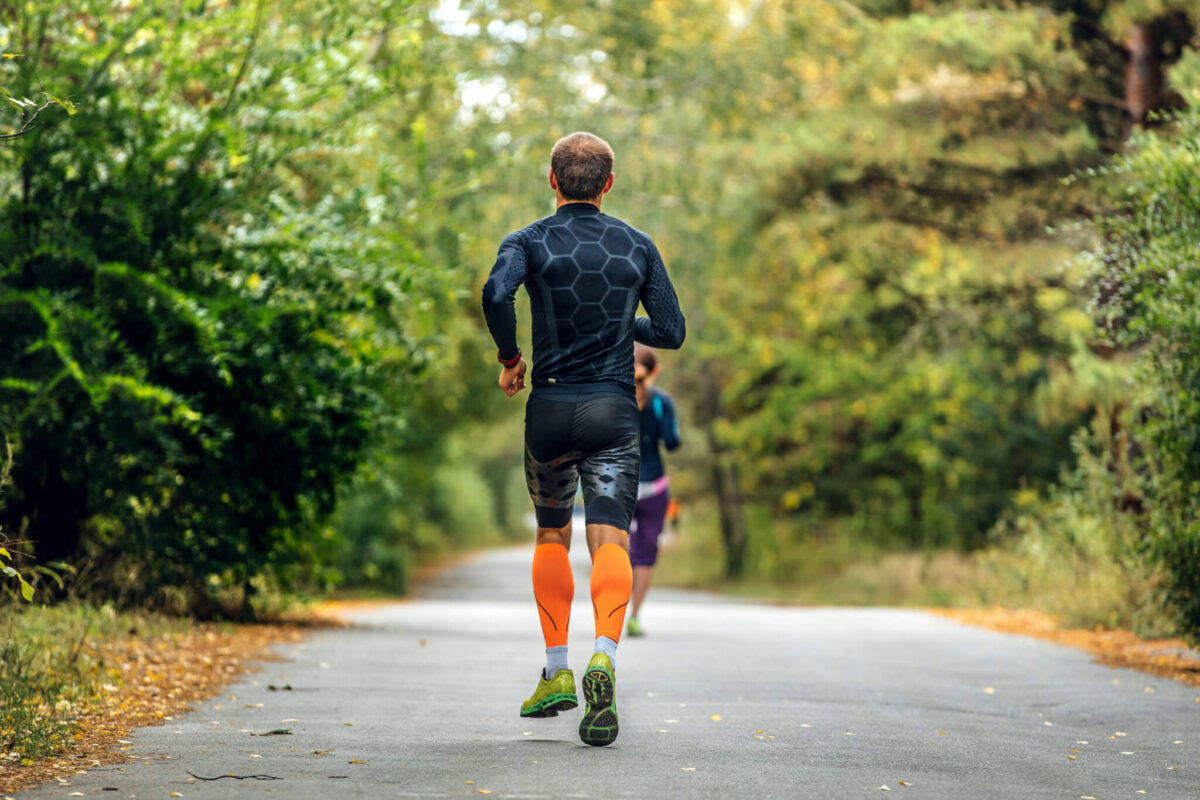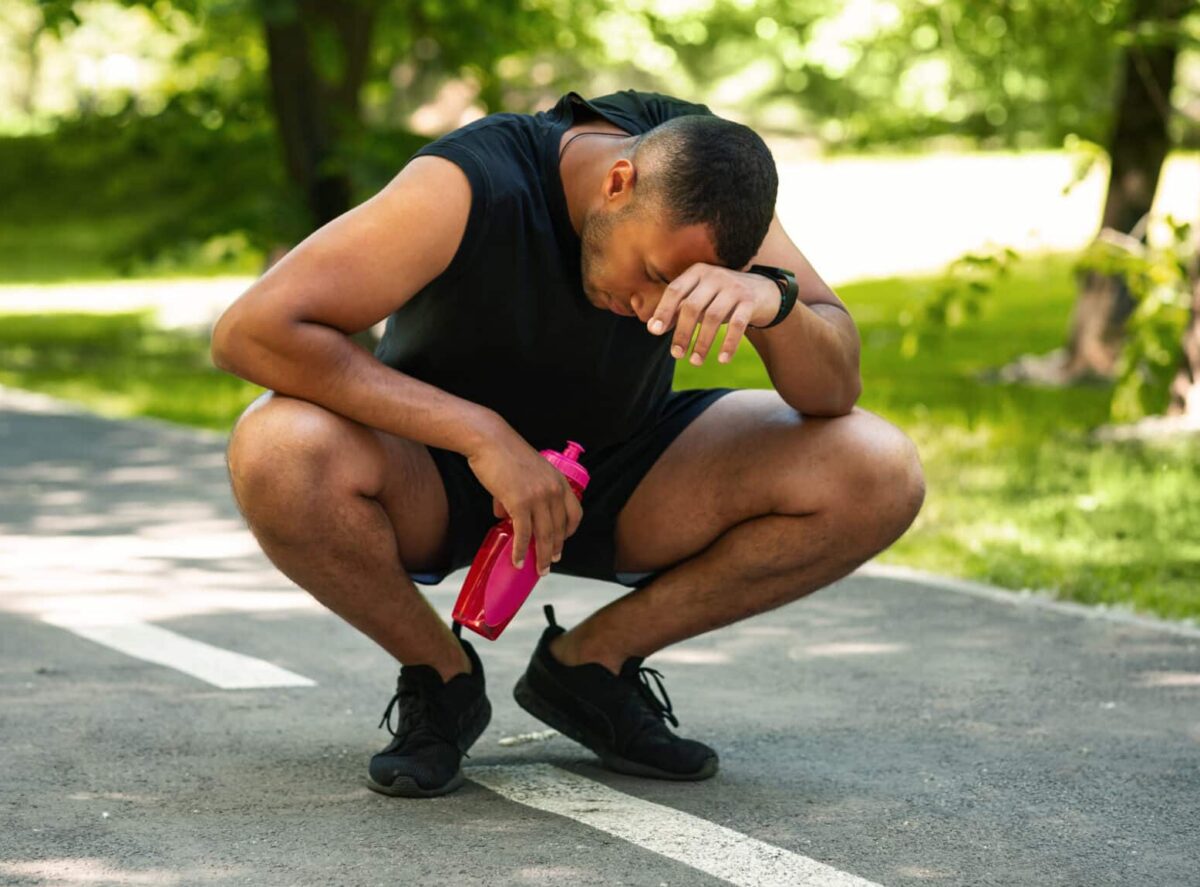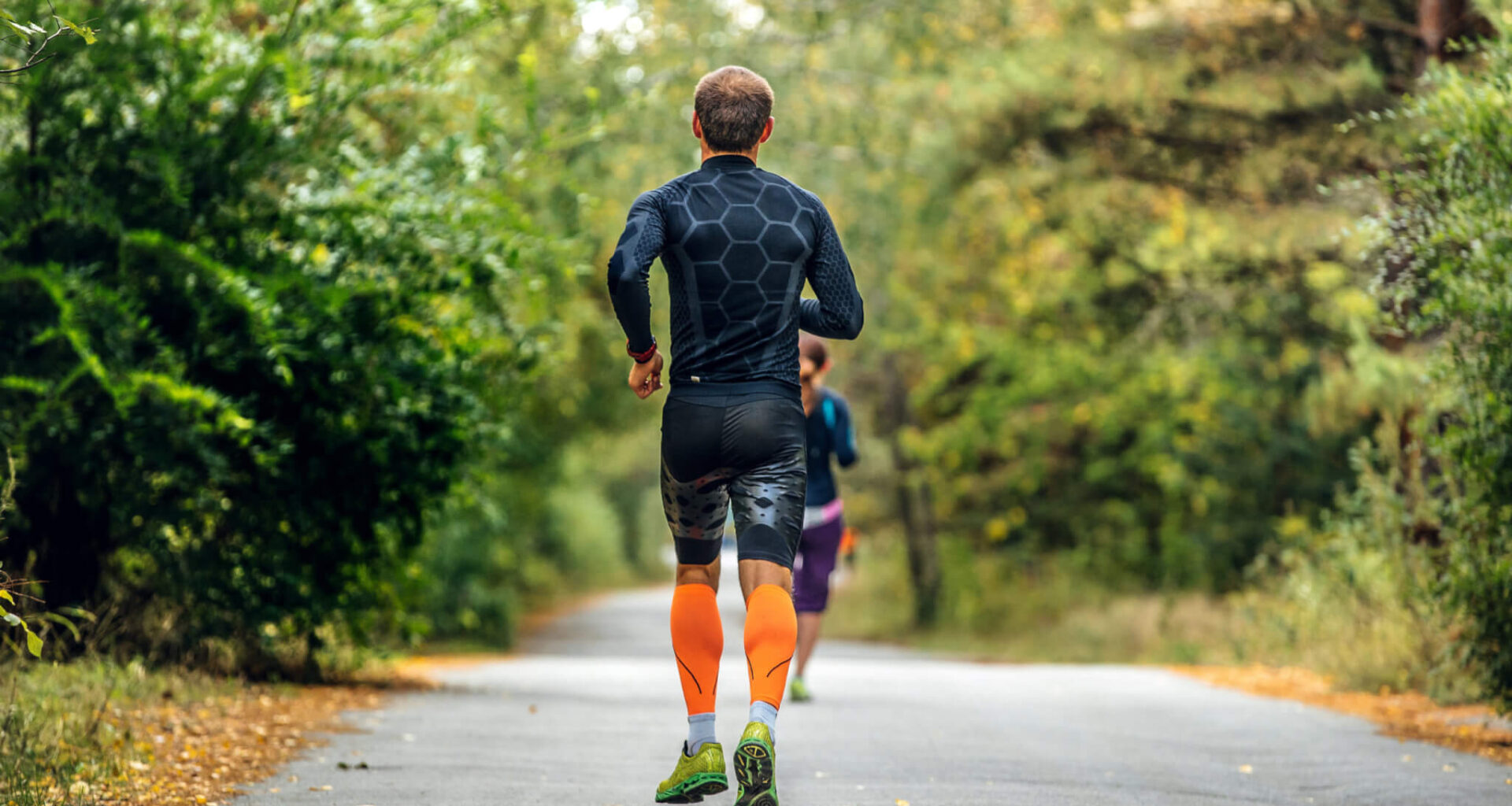
No water, no problem? Athletes may be better equipped to deal with the challenges of dehydration. (© sportpoint – stock.adobe.com)
Robust fitness appears to help the body exercise more while dehydrated.
In A Nutshell
Scientists removed water from laboratory mice for 24 hours after six days of wheel access. Control mice barely changed their running behavior, but selectively-bred High Runner mice significantly increased their distance.
Male High Runner mice increased running by 3,917 revolutions per day when water-deprived. Female High Runner mice added 1,925 revolutions. Both increases were statistically significant despite 17-20% body weight loss.
Researchers propose two explanations: High Runner mice may have superior physical capacity to exercise while dehydrated, or they may substitute running rewards for the lost reward of drinking water.
The counterintuitive finding challenges assumptions about how physical fitness interacts with dehydration stress, with potential implications for understanding athlete responses to heat and fluid loss.
Common sense tells us that when the body is dehydrated, physical performance declines. Athletes and coaches have long known that even modest fluid loss can hurt endurance and speed. However, research focusing on on laboratory mice has uncovered a puzzling exception. The fittest animals actually ran more, not less, when deprived of water for 24 hours.
Researchers at the University of California, Riverside tested what happens when mice go without water while given free access to running wheels. They used two types of mice. Normal control mice, as well as “High Runner” mice that had been selectively bred for decades to run about three times more than regular mice. When water bottles were removed for 24 hours, both groups lost roughly 20% of their body weight. On the other hand, their exercise responses couldn’t have been more different.
Running behavior among the control mice barely changed. High Runner mice, however, significantly ramped up their daily distance. Females ran an extra 1,925 revolutions when water-deprived. Males added a whopping 3,917 revolutions to their usual routine.
These findings, published in Physiology & Behavior, flip conventional wisdom and raise questions about how baseline fitness might fundamentally alter the body’s response to dehydration stress.
How Fitness Changes the Game
Most research on dehydration and exercise has focused on how fluid loss hurts performance. Studies typically show decreased work capacity, impaired thinking, and reduced voluntary activity. But those studies rarely account for baseline fitness differences.
The High Runner mice used in this study come from an ongoing breeding experiment that began in 1993. Every generation, scientists select the top runners to become parents of the next generation. Over 94 generations, this has created mice that voluntarily run three times more distance per day than regular mice. They’re basically the mouse equivalent of elite marathoners.
The selection process has fundamentally changed their biology. High Runner mice have larger kidneys, elevated stress hormones, and altered brain chemistry around motivation and pleasure. They have greater endurance and will voluntarily run at speeds closer to their maximum ability.
For this experiment, researchers used 268 adult mice. All mice got six days to acclimate to their running wheels with food and water available. On day six, researchers removed water bottles from half the mice. Then they measured what happened on day seven.
The stress hit all mice equally. Water-deprived females lost 18-20% of their body weight over 24 hours, regardless of type. Males lost 17-19%. Both groups ate less food when water was unavailable.
But their exercise responses split along fitness lines. Control mice with or without water barely changed their running. Female High Runner mice without water increased by 1,925 revolutions—a significant jump. Male High Runner mice without water surged upward by 3,917 revolutions.
Looking at duration told an interesting story too. Female mice across all groups showed minimal changes in how long they ran, while water-deprived males increased their running time dramatically. Control mice added 50 minutes per day, but High Runner mice added 113 minutes.

Study authors point out extreme heat events have become more common in recent years, increasing dehydration risk around the globe. (Credit: Maridav on Shutterstock)
Why Would Fit Mice Run More?
The researchers suggest two main explanations.
Physical capacity: High Runner mice might simply be better equipped to handle exercising while dehydrated. They have substantially higher endurance, meaning their hearts and metabolism can support more sustained activity. Their larger kidneys might help them manage water balance better. Higher stress hormones could help mobilize energy reserves.
In this view, all dehydrated mice might feel an instinctual drive to increase activity and search for water—much like hungry animals roam more to find food. But control mice lacked the physical ability to act on it effectively. Only the High Runner mice had enough gas in the tank to actually increase their running despite being dehydrated.
Reward substitution: Running on wheels is self-rewarding for rodents. It activates pleasure pathways in the brain. High Runner mice have altered reward systems, particularly changes in brain chemistry that affect motivation and pleasure.
When water is removed, these mice lose a primary source of satisfaction. Drinking when thirsty feels intensely good. The reward substitution idea proposes that High Runner mice compensate by ramping up another rewarding behavior: running. They substitute one pleasure for another.
Evidence for this comes from previous studies on the same mouse lines. One experiment found that High Runner mice consumed less artificial sweetener when given wheels, showing the reward from running was strong enough to reduce interest in sweets. Another study found they maintain more body fat despite running more, as if their bodies resist losing reserves that might limit their ability to run.
These findings paint a picture of mice where running has become so central to their reward system that it can partially substitute for basic biological drives like drinking.
What This Means for Human Athletes
The parallels to human athletes are intriguing, if speculative. Elite endurance athletes often describe feeling compelled to exercise, sometimes training through illness, injury, or rough conditions that would sideline most people. Some research shows that regular intense exercise can create dependence on the chemicals released during activity.
This study raises the possibility that highly trained people might respond to dehydration differently than sedentary folks. Standard recommendations about hydration are based largely on average responses. But if the fittest individuals have different responses to dehydration, one-size-fits-all guidelines might miss important distinctions.
The researchers also note that global warming is increasing extreme heat events and dehydration risk. Their results show that maintaining high fitness levels might help people better tolerate these stressors.
That said, the study shouldn’t be interpreted as approval for athletes to train while dehydrated. The mice lost substantial weight, far beyond what would be healthy. The increased running might represent a harmful response rather than a beneficial one. More research is needed to understand whether similar patterns occur in humans and what the health consequences might be.
What We Still Don’t Know
The study leaves important questions unresolved. Due to COVID-19 restrictions, researchers couldn’t measure actual physiological dehydration levels through blood or urine tests. This would reveal whether High Runner and control mice actually experienced the same degree of cellular dehydration, or whether the High Runner mice’s larger kidneys gave them some protection.
 Dehydration is never healthy. Studied mice lost significant weight during the experiment. (Photo by Prostock-studio on Shutterstock)
Dehydration is never healthy. Studied mice lost significant weight during the experiment. (Photo by Prostock-studio on Shutterstock)
The experiment only examined complete water removal for one day, not partial restriction or longer periods. In the real world, dehydration typically develops gradually. Whether the same fitness-dependent responses would appear with milder, longer-lasting water restriction remains unknown.
Researchers also didn’t measure what happened when water was returned. Did the High Runner mice immediately reduce their running? How long did it take for behavior and weight to normalize?
Finally, the study only examined wheel running. Mice also groom, rest, and explore their cages. Whether water deprivation affected these activities differently in High Runner versus control mice could help distinguish between general searching behavior and specific increases in running for reward.
By using mice selectively bred for high exercise, researchers could examine responses that might be too subtle to detect in regular populations. The finding that fitter mice responded so differently to dehydration shows that individual differences in fitness might fundamentally alter stress responses. This has relevance beyond dehydration, potentially affecting how different people respond to heat, altitude, illness, or other challenges.
As climate change makes extreme conditions more common, understanding these individual differences becomes increasingly important. The study adds fitness to the growing list of factors that can protect against environmental stressors, though much work remains to translate findings from selectively bred mice to diverse human populations.
For now, the fittest mice run more when dehydrated while average mice barely change their behavior. Whether elite human athletes show similar paradoxical responses remains an open question.
Disclaimer: This article is for informational purposes only and does not constitute medical, fitness, or professional advice. Always consult qualified healthcare providers regarding hydration strategies and exercise protocols.
Paper Summary
Methodology
Researchers used 268 adult laboratory mice from generation 94 of a breeding experiment. The study includes four lines selectively bred for high voluntary wheel-running (High Runner lines) and four non-selected control lines. Mice were given food and water while housed individually with running wheels for six days. Wheel revolutions were recorded in one-minute intervals for approximately 23 hours per day. On the evening of day six, water bottles were removed from half the mice. All mice were weighed at the start of wheel access, after six days, and after the seventh day. Wheel-running behavior was analyzed for the average of days five and six, as well as day seven, measuring total daily revolutions, duration of running, average speed, and maximum speed.
Results
Water deprivation for 24 hours caused significant body mass loss in all groups (18-20% in females, 17-19% in males), with no significant difference between High Runner and control lines. Control mice with or without water showed no significant changes in running distance from days 5-6 to day 7. High Runner females deprived of water significantly increased running distance by 1,925 revolutions per day. High Runner males deprived of water significantly increased running distance by 3,917 revolutions. For running duration, female mice showed little change across groups, but male mice of both types significantly increased running duration when water-deprived.
Limitations
Due to COVID-19 restrictions, the study could not measure physiological markers of dehydration like blood or urine concentration. The experiment only examined complete water deprivation for 24 hours, not partial water restriction or longer time periods. Food consumption and water intake were not measured, and wheel running was not recorded after water was returned. One computer failure resulted in loss of day-seven data for some mice. The study did not measure other behaviors besides wheel running or examine potential mechanisms like changes in hormones or kidney function during deprivation.
Funding and Disclosures
This work was supported by NSF grant IOS-2038528 to Theodore Garland Jr. The authors declared no conflicts of interest. All procedures were approved by the UCR Institutional Animal Care and Use Committee.
Publication Details
Schwartz, N.E., Alva, M.R., & Garland, T., Jr. (2025). Differential effects of acute total water deprivation on voluntary exercise behavior and body mass in laboratory house mice. Physiology & Behavior. Published online ahead of print. https://doi.org/10.1016/j.physbeh.2025.115139

